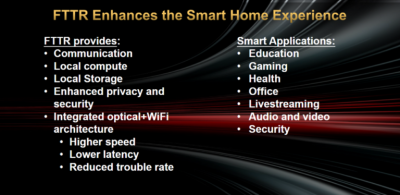 New requirements and a broad range of services and applications are calling for connectivity to be ubiquitous to cater and provide the Quality of Experience desired for all smart home and IoT use cases.
New requirements and a broad range of services and applications are calling for connectivity to be ubiquitous to cater and provide the Quality of Experience desired for all smart home and IoT use cases.
“It is not just about connecting your smart home devices to the internet, it is about having all these devices communicating with each other within the home to improve the customer experience,” said Futurewei Technologies Principal Engineer, Tom Starr.
However online services – such as remote working and live streaming – now prominent in every room, obstructions and slow speeds can limit the experience. According to Starr, “Wi-Fi cannot reach everywhere in the home reliably.”
Fiber to the Room (FTTR) can tackle the obstacles in the home such as walls – which can attenuate Wi-Fi signals – and function optimally regardless of the distance from the home gateway. Allowing for multiple home gateways and the ability to support more than 250 devices within the home, FTTR enhances the performance of the home Wi-Fi network by providing a dedicated backhaul to each room. This ensures less pack loss, and the low latency and high bandwidth required for a quality experience for each smart home and IoT device.
Starr also assured the audience in San Diego that FTTR is not as difficult to install as people think. The technologies tight bend radius and the addition of fiber adhesive tape, means that technicians can avoid labor intensive installation activities such as fishing wires through walls. This allows for quicker deployments, resulting in a faster time to market of services for operators.
 Starr stated that FTTR, as the next generation home networking technology, will help build leading brand and competitive advantages for service providers. With its assurance of fast speeds and minimal delay, service providers can improve customer acquisition and churn rate, and continuously improve ARPU as the reliance on real-time applications increase in the home.
Starr stated that FTTR, as the next generation home networking technology, will help build leading brand and competitive advantages for service providers. With its assurance of fast speeds and minimal delay, service providers can improve customer acquisition and churn rate, and continuously improve ARPU as the reliance on real-time applications increase in the home.
An “IoT coffer” was proposed by Starr to provide further value-added services for the customer and to protect valuable data and devices in the home. Having a security functionality in the residential gateway to prevent unauthorised access to the home network can be facilitated through collaboration and open standards.
